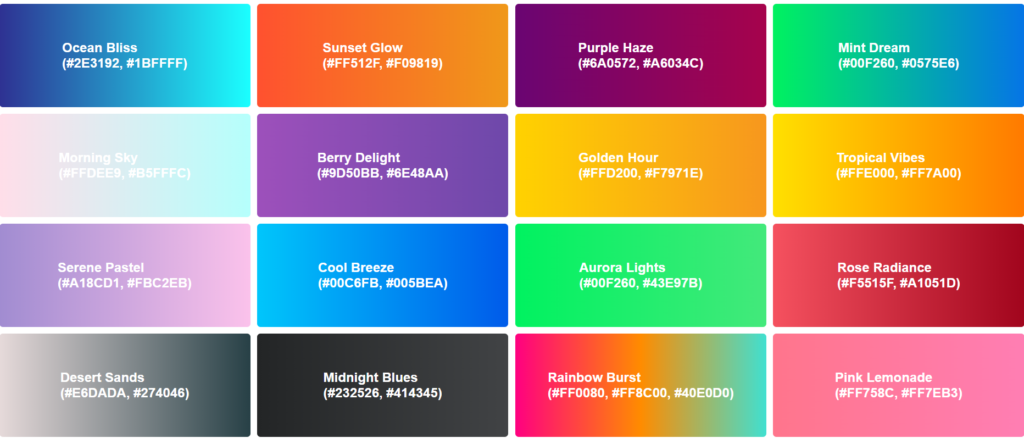Linear vs. Radial Color Gradients
Color gradients are an essential design tool that adds depth, visual interest, and a modern aesthetic to digital and print media. They transition smoothly from one color to another, creating dynamic visual effects.
Gradients are widely used in web design, branding, user interfaces, and even fine art. Among the most common types of gradients are linear and radial gradients. Understanding their differences, applications, and how to create them effectively is key to mastering this versatile design element.
Content
What Are Color Gradients?
A color gradient is a gradual blend of colors that can involve two or more hues. Gradients can add texture, create a sense of movement, and make designs more engaging. They can range from simple two-color blends to complex, multi-hued creations.
Types of Gradients
- Linear Gradients: Transition occurs along a straight line.
- Radial Gradients: Transition radiates from a central point.
- Angular (Conic) Gradients: Transition sweeps around a center like a pie chart (not covered in detail here).
In this article, we’ll focus on linear and radial gradients to explore their fundamental differences and usage.
Linear Gradients: Definition and Use Cases
What Is a Linear Gradient?
A linear gradient blends colors along a straight axis. The colors change uniformly from one edge to another. This direction can be vertical, horizontal, diagonal, or any custom angle.
Example Directions:
- Vertical Gradient: From top to bottom.
- Horizontal Gradient: From left to right.
- Diagonal Gradient: At any angle, such as 45° or 135°.
Use Cases for Linear Gradients
- Backgrounds: Linear gradients are frequently used in web design to add subtle texture or vibrant backdrops.
- Buttons and Call-to-Actions: Gradients make clickable elements stand out.
- Typography: Adding gradients to text creates a modern and attention-grabbing look.
- Charts and Visualizations: Gradients help highlight data trends.
Key Characteristics of Linear Gradients
- Directionality: You can control the direction of the gradient flow.
- Smooth Transition: Colors blend seamlessly along the chosen axis.
- Versatility: Works well in modern, flat, and minimalistic designs.
CSS Example:
| background: linear-gradient(90deg, #ff7e5f, #feb47b); |
Radial Gradients: Definition and Use Cases
What Is a Radial Gradient?
A radial gradient spreads colors outward in a circular or elliptical pattern from a central point. The gradient transitions radiate symmetrically or asymmetrically, depending on the shape and size.
Shapes:
- Circle: Equal radius from the center.
- Ellipse: Wider or taller spread, creating an oval gradient.
Use Cases for Radial Gradients
- Logos and Branding: Adds dimensionality and a focal point to logos.
- Backgrounds: Often used to create a spotlight effect or draw attention to the center of a design.
- Overlays: Creates vignette effects in photos or design elements.
- Icons: Adds depth and visual complexity to icons and symbols.
Key Characteristics of Radial Gradients
- Central Focus: The design emphasizes the central point where the gradient starts.
- Dynamic Appearance: Ideal for creating depth or spotlight effects.
- Emotional Impact: Often used to evoke feelings of warmth, energy, or focus.
CSS Example:
| background: radial-gradient(circle, #ff7e5f, #feb47b); |
Comparing Linear and Radial Gradients
| Feature | Linear Gradient | Radial Gradient |
| Transition Path | Straight line | Radiates outward from a central point |
| Directional Control | Customizable direction | Based on the center and shape |
| Visual Focus | Emphasizes flow or movement | Emphasizes a central focal point |
| Use Cases | Backgrounds, buttons, typography | Logos, backgrounds, spotlight effects |
| CSS Syntax | linear-gradient(angle, colors) | radial-gradient(shape, colors) |
Designing with Gradients: Best Practices
1. Choose the Right Type
Decide whether your design benefits more from a linear flow or a central focus. Use linear gradients for horizontal or vertical emphasis and radial gradients for circular or spotlight effects.
2. Limit Colors
Stick to 2-3 colors for most gradients to avoid visual clutter. Subtle gradients often look more professional.
3. Blend Harmoniously
Ensure that the transition between colors is smooth. Use analogous or complementary colors for a visually pleasing effect.
4. Experiment with Opacity
Overlay gradients with transparency can create striking visual layers.
5. Test Responsiveness
Make sure gradients look good across devices and screen sizes, especially for web applications.
Advanced Techniques
Multi-Stop Gradients Add multiple color stops to create more complex blends.
| CSS |
| background: linear-gradient(45deg, #ff7e5f, #feb47b, #86a8e7); |
Blending Modes Combine gradients with background images or textures using blending modes in CSS or design software.
Animations Animate gradients to create dynamic and engaging effects.
| CSS |
| background: linear-gradient(90deg, #ff7e5f, #feb47b); animation: gradientShift 5s infinite; |
Tools to Create Gradients
- Online Generators: Tools like CSS Gradient or UI Gradients simplify gradient creation.
- Design Software: Adobe Photoshop, Figma, and Canva offer robust gradient editing features.
- Code Editors: Use CSS directly to customize gradients for web design.
Conclusion
Linear and radial gradients are powerful tools that can transform your designs. Linear gradients are ideal for creating directional flow and subtle backgrounds, while radial gradients draw the viewer’s attention to a focal point. By understanding their unique characteristics and applications, you can enhance your design projects and create visually captivating elements.
Experiment with these gradients, combine them with other effects, and let your creativity shine!


